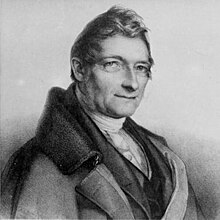Biography
His father was a wind instrument manufacturer, originally from Mainburg, who died while Franz was still in school. As a result, he was transferred to a convent school and finished his studies at the Alten Gymnasium in 1807. He was unable to pursue his education further, due to lack of funds and poor health. Instead, he entered the civil service of the newly established Kingdom of Bavaria.
His superiors were impressed by his skills in calligraphy. Meanwhile, he was contemplating a system that would make writing faster and easier. In 1817, he began to develop his system. As the German bureaucracies expanded, rapid transcription became essential. England and France already had such systems, but they proved difficult to adapt to German. Gabelsberger's method caught on quickly, and he became the first stenographer for the Bavarian State Parliament.
He was also promoted to Ministerial Secretary, and his system was certified by the Bavarian Academy of Sciences and Humanities as being more reliable and legible than previous systems. Later, he was awarded 1,000 Gulden per year, half of which was to be used for his shorthand students. His method was officially named and published in 1834. He designed an abbreviation typeface in 1840.
In 1849, he suffered a stroke while out for a walk, and died shortly after. He was interred in the Alter Südfriedhof. From then until 1902, his system was revised three times. By that time, the number of users was estimated to be four million. Monuments have been dedicated to him in Munich, Vienna, and Traunstein. Streets in numerous German and Austrian cities are named after him. The medal of honor awarded by the German Stenographers' Association bears his likeness.

Franz von Baader, born Benedikt Franz Xaver Baader, was a German Catholic philosopher, theologian, physician, and mining engineer. Resisting the empiricism of his day, he denounced most Western philosophy since Descartes as trending into atheism and has been considered a revival of the Scholastic school. He was one of the most influential theologians of his age but his influence on subsequent philosophy has been less marked. Today he is thought to have re-introduced theological engagement with Meister Eckhart into academia and even Christianity and Theosophy more generally.
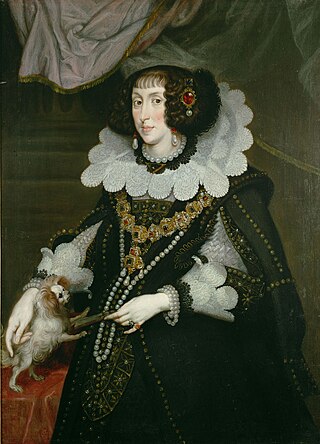
Archduchess Maria Anna of Austria, was a German regent, Electress of Bavaria by marriage to Maximilian I, Elector of Bavaria, and co-regent of the Electorate of Bavaria during the minority of her son Ferdinand Maria, Elector of Bavaria from 1651 to 1654.

Maria Anna of Bavaria was a politically active Archduchess of Austria by her marriage to Archduke Charles II of Austria. She played an important role in the Counter-Reformation in Austria.
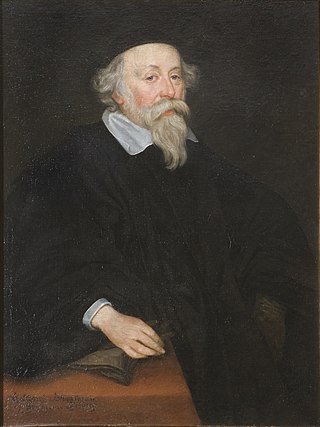
John Casimir, Count Palatine of Zweibrücken-Kleeburg was the son of John I, Count Palatine of Zweibrücken and his wife, Duchess Magdalene of Jülich-Cleves-Berg. He was married to Catherine of Sweden and was the founder of a branch of Wittelsbach Counts Palatine often called the Swedish line, because it gave rise to three subsequent kings of Sweden, but more commonly known as the Kleeburg line.
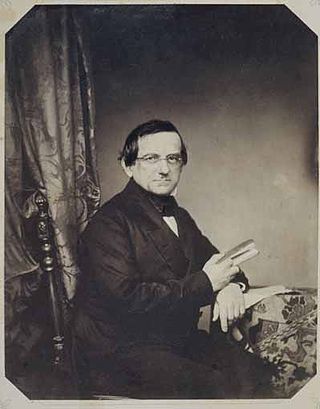
Franz Xaver Ritter von Gietl was a German physician.

Martin Wilibald Schrettinger was a German priest and librarian.
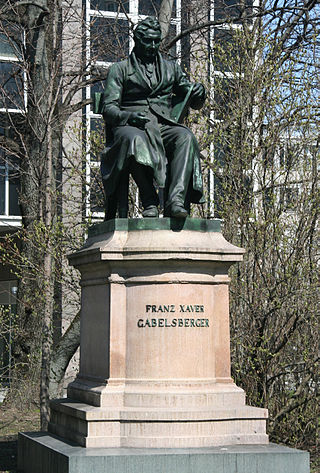
Memorial for Franz Xaver Gabelsberger is a monument located in Maxvorstadt, Munich, Bavaria, Germany. The monument is a bronze sculpture by the German sculptor Syrius Eberle. It was dedicated shortly after the hundredth anniversary of the birth of Franz Xaver Gabelsberger (1789-1849), the inventor of a cursive shorthand system. Casting was by Ferdinand von Miller.
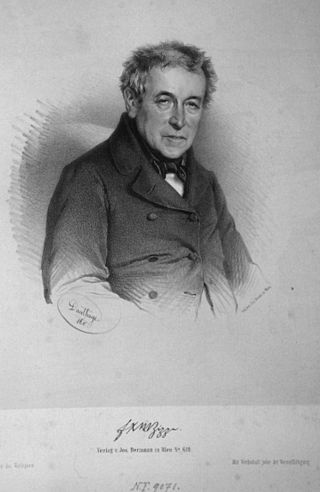
Franz Xaver Maximilian Zippe, was a Bohemian natural philosopher, scientist and mineralogist.
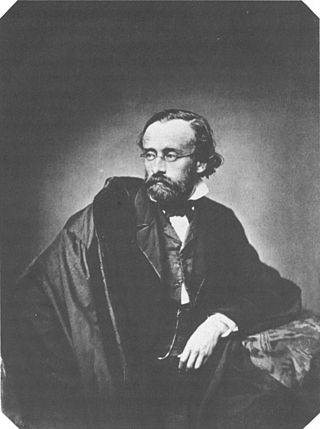
Eduard Schleich was a German painter. He is generally referred to as The Elder to distinguish him from his son Eduard, who was also a painter.

Franz Ignaz Oefele was a German painter, etcher, and miniaturist. His name is sometimes spelled "Öffele" and is occasionally seen as "Oeffele-Piekarski", for reasons unknown.

Hermann Kauffmann also Herrmann Kauffmann was a German painter and lithographer, and one of the main representatives of the Hamburger Schule.
Franz Xaver von Schönwerth was a Bavarian civil servant who was an important collector of folklore in the Upper Palatinate region.
Friedrich Wilhelm Ghillany was a German Lutheran theologian, historian, librarian and publicist.
Wilhelm Franz Josef Kosch was an Austrian historian of literature and theatre and lexicographer. The lexicon that he conceived and later revised several times, the Deutsches Literatur-Lexikon is a references in the field of German literature.
Clemens Alois Baader, also spelled Klement Alois Baader or Klemens Alois Baader was a German Roman Catholic theologian.
Heinrich Ferdinand Mannstein, real name Heinrich Ferdinand Steinmann, was a German singing teacher, writer and music critic.

Georg Eduard Hallberger, after 1869: von Hallberger was a German publisher and businessman.

Franz Hoppé, also Franz Hoppe, was a German actor and operatic baritone.

Carl Greith, also Karl Greith, was a Swiss composer and church musician.

Hermann Joseph Mitterer, was a German drawing teacher, founder of Munich's Feiertägliche Zeichnungsschule in 1792 and co-founder of Feiertagsschule München in 1793, forerunners of later vocational schools. On Mitterer's initiative, drawing lessons were made compulsory in all schools in Bavaria as early as 1789. He also founded the first Lithographische Kunstanstalt.
This page is based on this
Wikipedia article Text is available under the
CC BY-SA 4.0 license; additional terms may apply.
Images, videos and audio are available under their respective licenses.
